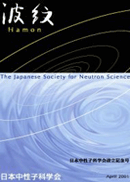
- Issue 4 Pages 270-
- Issue 3 Pages 212-
- Issue 2 Pages 110-
- Issue 1 Pages 2-
- |<
- <
- 1
- >
- >|
-
Kenya Kubo2010 Volume 20 Issue 4 Pages 270-273
Published: 2010
Released on J-STAGE: November 16, 2018
JOURNAL FREE ACCESSA neutron in-beam Mössbauer spectrometer has been developed at the JRR-3 beam hall at the JAEA Tokai campus. Application of a PPAC detector together with noise reduction successfully lead to a unique Mössbauer spectrum measurement system. An example of applications to iron disulfide systems is briefly described.
View full abstractDownload PDF (1267K) -
Ryoko Oishi-Tomiyasu2010 Volume 20 Issue 4 Pages 274-280
Published: 2010
Released on J-STAGE: November 16, 2018
JOURNAL FREE ACCESSThe uniqueness of solutions is one of the conditions proposed by J. Hadamart to judge whether an inverse problem is well-posed or not. In order to reflect on ab-initio powder structure analysis and powder indexing from this aspect, we introduce several mathematical theorems and their translation into statements on the uniqueness of solutions. As another application of mathematics, a new thorough search algorithm for powder indexing is presented. It is robust to false peaks caused by impurities.
View full abstractDownload PDF (1170K) -
Takeshi Nakatani2010 Volume 20 Issue 4 Pages 281-285
Published: 2010
Released on J-STAGE: November 16, 2018
JOURNAL FREE ACCESSThe first neutron was produced on May 2008 in Japan Proton Accelerator Research Complex (J-PARC) / Materials and Life science experimental Facility (MLF). The MLF computing environment group is developing an advanced data acquisition and analysis environments for neutron experiments according to a long-range objective. We have introduced the standard data acquisition system which records the neutron signal from detectors with event by event. This event data recording system acquires neutron detection data with the “DAQ-Middleware” which is the flexible and scalable data acquisition software. The standard data analysis framework, “Manyo-Lib”, is written in C++ and class library. Manyo-Lib is a software infrastructure and provides the libraries for building data input/output functions, data-analysis functions, and distributed data processing, etc. MLF users can operate the experimental instrument through MLF software framework called “IROHA” which unifies these software components.
View full abstractDownload PDF (1386K) -
Koichiro Sadakane2010 Volume 20 Issue 4 Pages 286-291
Published: 2010
Released on J-STAGE: November 16, 2018
JOURNAL FREE ACCESSThe effect of an antagonistic salt, NaBPh4, on a mixture of D2O / 3-methylpyridine (3MP) is investigated by visual observation, optical microscopy, small-angle neutron scattering (SANS) and neutron spin echo (NSE). In the case that the amount of NaBPh4 is smaller than 15 mM, the mixture colors in near-critical region. With increasing the amount of salt, the phase separation disappears and a single peak profile is observed at finite-Q by SANS. Furthermore, a structural phase transition between a disordered-phase and an ordered-lamellar-phase are confirmed in D2O-rich region. The characteristic length of those structures is sub-micrometers. In this condition, a dispersion relation of these structures was measured using NSE, which showed a momentum transfer cubed relation. This result implies that the dynamics of the system might be predominantly determined by membrane fluctuations. The present results indicate that the 3MP domains are microscopically separated from water and the domains behaves as membranes. A preferential solvation to each solvent can induce the microphase separation between the solvents.
View full abstractDownload PDF (2568K) -
Andika Fajar, Gunawan, Alan Maulana, Muhamad Refai Muslih, Tri Hardi ...2010 Volume 20 Issue 4 Pages 292-301
Published: 2010
Released on J-STAGE: November 16, 2018
JOURNAL FREE ACCESSNeutron scattering laboratory (NSL) in Serpong, Indonesia which utilizes a 30 MW multi-purposes G. A. Siwabessy reactor (RSG-GAS) consists of seven neutron beam instruments. There are three diffractometers, i.e. residual stress measurement diffractometer, single crystal structural determination and texture measurement (FCD/TD) diffractometer, and high-resolution powder diffractometer (HRPD); three spectrometers, i.e. triple axis spectrometer (TAS), small-angle neutron scattering (SANS) spectrometer and high-resolution small-angle neutron scattering (HRSANS) spectrometer; and one thermal neutron radiography facility (NRF). The current status of each instrument and its performance are presented in this report including current and the future development as well as the research programs.
View full abstractDownload PDF (1985K)
-
Koji Yoshida, Toshio Yamaguchi2010 Volume 20 Issue 4 Pages 302-306
Published: 2010
Released on J-STAGE: November 16, 2018
JOURNAL FREE ACCESSWater confined in nanometer-scale pores exists under various conditions, such as water in rock, sandstones, proteins and membranes. The properties of confined water are very different from those of bulk water. Neutron spin echo (NSE) method covers suitable length and time scales to investigate the dynamics of confined water. An NSE study of confined water is exemplified on heavy water (D2O) confined in porous silica glass MCM-41 C10 (pore diameter 2.04 nm). D2O in C10 is stable as liquid over a temperature range down to 140 K. The intermediate scattering functions are analyzed by the Kohlrausch-Williams-Watts stretched exponential function. The relaxation times of confined D2O in capillary condensed state follow remarkably well the Vogel-Tamman-Fulcher equation between 298 and 220 K, whereas below 220 K they show an Arrhenius type behavior. That is, the strong-to-fragile (STF) dynamic crossover occurs, which has never been seen in experiments on bulk water. On the other hand, for monolayer D2O, the STF dynamic crossover was not observed in the temperate range measured. This could reflect the partial breaking of the hydrogen bonds of surface water.
View full abstractDownload PDF (1150K)
- |<
- <
- 1
- >
- >|